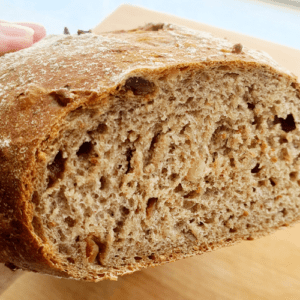Fig & Walnut Bread

Fig and walnut bread is a type of bread that contains dried figs and chopped walnuts in the dough. Mine is made with a combination of wheat flour, yeast, water, salt, honey, cinnamon and mixed spice. The figs and walnuts add texture and flavour to the bread, creating a slightly sweet and nutty taste. It is often served as a breakfast or snack bread, and can be toasted and topped with butter or jam for added flavour.
It is an absolute must on a platter or cheese board at my place!
The bread itself has a soft and chewy texture, and the nuts and figs provide a slight crunch. The bread also has a subtle honey and cinnamon flavour as well. Delish!
Equipment
- TM5 or TM6
- Bowl Scrapper
- Large Bowl
- Dough Cutter
- Thermomix Baking Mat
- Lame
- Oven Tray
- Oven Tray Liner
- small sieve for flour
Ingredients
- Yeast – Instant dry yeast, its best to store this in the fridge for longevity
- Honey – for sweetness
- Warm water – to help activate the yeast, don’t use hot!
- Flour – a mix is used, see below
- Cinnamon and Mixed Spice – added for a lovely warm flavour
- Salt – added for flavour, use a table or ground salt not flaked
- Dried Figs – for sweetness
- Walnuts – for crunch and a slight bitterness – pre roast for extra flavour

Why use plain and bakers bread flour?
Plain flour, also known as all-purpose flour, and bread flour, also known as baker’s flour, have different protein contents, which can affect the texture and structure of bread.
Plain flour has a lower protein content than bread flour, which makes it ideal for recipes that require a more tender crumb, such as cakes and pastries. However, plain flour may not be suitable for bread recipes that require a higher protein content to create a sturdy structure.
Bread flour, on the other hand, has a higher protein content than plain flour, typically between 12% to 14%. The higher protein content allows the dough to develop stronger gluten strands, which can help create a chewy and airy texture in bread.
In this recipe I have, used a combination of plain flour and bread flour to create a balance between a tender crumb and a sturdy structure.
.
Substitutions/Additions
- Instead of walnuts, use whatever nuts you have in the pantry, almonds, hazelnuts or pistachios are a good choice.
- Replace the dried figs with other dried fruits such as raisins, apricots or cranberries.
- For extra flavour, add the grated zest of an orange and add to the dough when you add the fruit and nuts.
- If you don’t have bakers flour you can use all plain flour, but it will impact on the structure of the loaf.
Proofing
Proofing is an important step in the bread-making process that involves allowing the dough to rise before baking. Here are some tips for proofing bread:
- Choose a warm, draft-free location: Bread dough needs a warm, humid environment to rise properly. Choose a location in your kitchen that is free from drafts and has a consistent temperature. You can use a proofing box or warm oven (40 degrees) to create an ideal environment.
- Cover the dough: Cover the dough with a damp towel or plastic wrap to keep it moist and prevent it from drying out. This will also help to trap in the yeast’s carbon dioxide, which helps the dough rise.
- Let the dough rise until doubled in size: The dough may take anywhere from 45 mins to 2 hours to rise. Check the dough periodically to see if it has doubled in size. Do not let it overproof, as this can cause the bread to collapse during baking.
- Use the poke test: To check if the dough is properly proofed, gently poke it with your finger. If the indentation remains, the dough is ready to bake. If the dough springs back, it needs more time to rise.
- Don’t rush the process: Proofing takes time and patience. Rushing the process by using too much yeast or warm water can result in a flat or dense loaf of bread. Follow the recipe and allow the dough to rise at its own pace for the best results.
By following these tips, you can ensure that your bread dough is properly proofed and ready to bake, resulting in a delicious loaf of bread.

Is the bread cooked?
There are several ways to tell if bread is ready:
- Tap Test: Tap the bread with your finger or knuckle. If it sounds hollow, it is usually a sign that the bread is done. This method works best for larger loaves of bread.
- Visual Check: Look at the colour of the bread. Bread that is golden brown on the outside and has a slightly darker crust is usually a sign that it is ready.
- Internal Temperature: Use a food thermometer to check the internal temperature of the bread. For most bread, the internal temperature should be between 88°C to 99°C when done.
- Time: Follow the recommended baking time in the recipe. If you are unsure, you can always bake the bread for a little longer and check it periodically until it looks and feels done.
Because every oven is different, use cooking times as a guide. It’s always a good idea to check multiple methods to ensure that the bread is cooked through and ready to enjoy.

How to store Fig & Walnut Bread
To store fig and walnut bread, follow these steps:
- Allow the bread to cool completely before storing it. This will prevent moisture from building up inside the bread and causing it to become soggy.
- Wrap the bread in plastic wrap or aluminium foil to protect it from air and moisture. You can also place the bread in an airtight container.
- Store the bread at room temperature for up to 2 days. If you want to keep it for longer, you can store it in the refrigerator for up to a week.
- To freeze the bread, wrap it tightly in plastic wrap and place it in an airtight container or freezer bag. Freeze for up to 3 months. When you are ready to eat it, allow it to thaw at room temperature or in the refrigerator before serving.
It’s important to note that storing bread in the refrigerator or freezer may cause it to become slightly dry or stale. To freshen up the bread, you can wrap it in damp paper towels and heat it in the oven for a few minutes before serving.

Fig & Walnut Bread
Equipment
- TM5 or TM31
- Lined oven Tray
- Large Bowl for proofing dough
- Bowl Scraper
- Bench Scraper
Ingredients
- 1 1/2 tsp dried Instant yeast
- 20 grams honey
- 220 grams warm water
- 160 grams plain flour
- 160 grams bakers flour
- 1 tbsp ground cinnamon
- 1 tsp mixed spice
- 1 tsp table salt
- 100 grams dried figs
- 50 grams walnuts
- 1 tsp vanilla Extract optional
- Extra flour for dusting
Instructions
- Roast 50g walnuts in a preheated 180 °oven for 10mins. Cool and roughly chop. Set aside
- Add 1 1/2 tsp yeast, 20g honey and 220g warm water to Thermomix Bowl. Warm 4 mins/37°/speed 1
- Add 160g plain flour, 160g bakers flour, 1 tbsp cinnamon, 1 tsp mixed spice, 1 tsp table salt, 1 tsp vanilla essence. Mix on dough for 3 mins.
- Meanwhile, chop figs and sprinkle on a little flour to prevent sticking.
- Add walnuts and figs to Thermomix bowl with dough and knead again on dough mode for 2 minutes.
- Oil a large bowl. Place dough into bowl, cover and prove until double in size, (see notes in blog post)
- Preheat oven to 180° (fan)
- Knock dough down and shape into an oval loaf and place onto a lined baking tray. Make a shallow slit down the centre of the bread and dust with flour. Cover and let prove on the kitchen bench for approx 30 mins.
- Quickly, place bread into hot oven and using a water sprayer, spray water into the oven. Cook 15 minutes, quickly open oven and spray once more. Continue cooking until bread is golden brown and a hollow sound is heard when you tap on the bottom, (25 – 30 mins)
- Transfer to a wire rack to cool.
- Enjoy!
